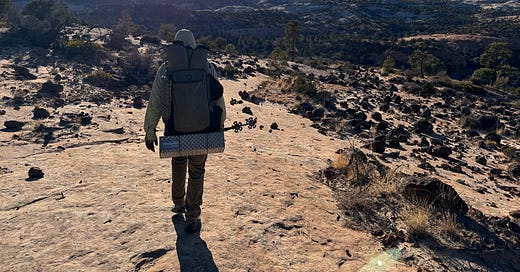Post summary
I’m currently on an 850-ish-mile hike through the desert.
I’ll be hiking 20 to 30 miles a day for the next ~45 days.
This post details how I trained for the hike and why this type of training is ideal for being SUPERMEDIUM and improving healthspan and lifespan.
I’ll also explain my training philosophy for big events like this.
Housekeeping
Full access to this post is for Members of Two Percent. Members get full access to all three weekly Two Percent posts and podcasts.
Become a Member:
Check out our partners, who’ll get you healthy and help you live well:
🚨🚨 New partner alert: Patagonia Provisions offers some of the healthiest protein on earth. Their tinned fish is high in protein, sustainable, and packed with omega-3s, calcium, potassium, and magnesium in amounts that research shows offers clinical benefits. Eat tinned fish, live better, and do Mother Nature good. Use discount code EASTER15 for 15% off your first purchase.
Function Health offers 5x more testing than typical blood work. Function now tests for “forever chemicals" (PFAS)—potentially harmful substances found in nonstick cookware, food packaging, and even drinking water. PFAS can impact hormones, immunity, and overall health. Your Function results are reviewed by a clinician, but work with your doctor to analyze your results.
GOREWEAR. I’ll be using the hell out of GOREWEAR gear on the trail. Especially the Concurve LE3 Jacket. It’s light, weatherproof, and has a bunch of features that make it ideal for all outdoor runs, hikes, rides, and more. Check it out. EASTER gets you 30% off your first GOREWEAR purchase.
Audio/podcast version
The post
Yesterday morning, I began a 850-ish-mile hike through the Southwest. Read Monday’s post for more information about the hike and why I’m doing it.
The Hayduke Trail isn’t your typical thru hike—those miles won’t be on easily-navigable, well-trodden trails close to civilization.
That’s because the Hayduke isn’t really a “trail.” It’s more of a “route.” Hikers follow some loose suggestions of where to go and find their way across the most remote stretch of desert in the lower 48 states. No two hikers take the same path.
But it’s good to get out there and in it. As Edward Abbey said:
“In the first place you can't see anything from a car; you've got to get out of the goddamned contraption and walk, better yet crawl, on hands and knees, over the sandstone and through the thornbush and cactus. When traces of blood begin to mark your trail you'll see something, maybe.”
I’ll cover around 20 to 30 miles a day. And those miles will require a lot of rambling and scrambling: Across raw desert, up and down cliffs, through slot canyons, and more.
There will be many ascents and descents—I’ll hit a high point on Mt. Ellen, which is about 11,500 feet above sea level, and bottom out around 2,000 feet in the Grand Canyon (and then, of course, immediately be forced to hike five thousand vertical feet out of the canyon).
All the while, I’ll carry everything I need in a pack, which will weigh 18 to 40 pounds, depending on food and water.
Over the last handful of months, I’ve been trying my damndest to get my body ready for the endeavor.
Below I’ve explained what a typical week of training looks like. You might not be attempting a long hike anytime soon, but this plan hits all the tenets of being SUPERMEDIUM.
It gives you killer endurance (especially for rucking)
It gives you a high strength-to-weight ratio so you’re strong as hell but not weighed down by excess muscle.
It bulletproofs your body so you can practice Rule 2: Don’t die.
Training for the outdoors, IMO, is the best path to functional fitness and improved healthspan and lifespan. Read more on that idea here.
A week of training
Here’s a rough sample week of what I did to physically prepare for the hike.




